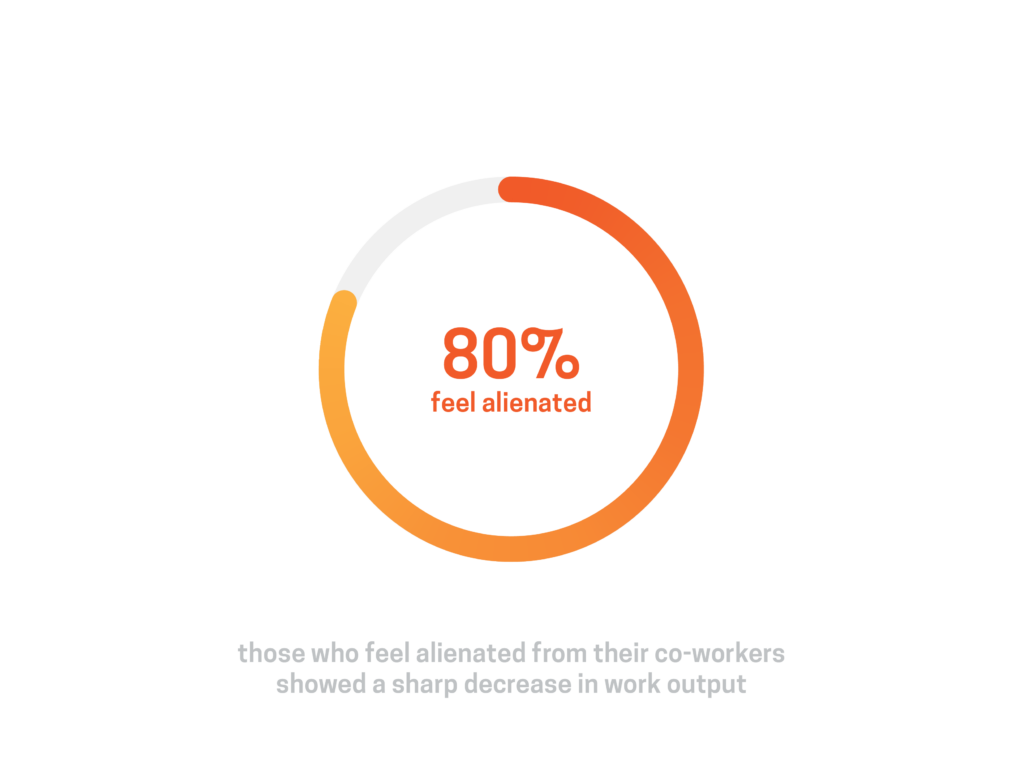The Five Pillars of Wellbeing highlights the primary elements of a person’s whole wellbeing. In this blog, we’re talking about how physical, career, financial, social, and emotional wellbeing relates to the workplace and ways that we can further foster a healthy work environment.
Why is Wellbeing Important in the Workplace?
The mental wellbeing of our workforce is at an all-time low. One recent global research survey of employee assistance programs found that nearly one-third of workers (31%) reported a worsening in their mental wellbeing over the previous 12 months, up from 24% at the end of 2020.1
Although there are several elements that contribute to elevated mental health support, there are five pillars that organisational leaders should actively work to address.
We need to develop a basic understanding of the current state of wellbeing within the workplace. The most effective way to positively impact these pillars is to be able to pinpoint the pain areas, and further identify the goals and next steps for your organisation.
In recent years, 68% of millennials and 81% of Generation Z removed themselves from their occupation for mental health reasons, both voluntarily and involuntarily.2 It’s quite possible that your team members are struggling with their wellbeing at this very moment in time, without bringing their internal conflicts to your immediate attention.
As leaders, we must prioritise our own education on wellbeing and learn how to identify wellbeing concerns within our teams.
Pillar 1: Physical Wellbeing
Physical and psychological wellbeing are synonymous with each other. This connection is what makes physical wellbeing so important, as studies show that an organisation that nurtures physical wellbeing will notice a shift in their team’s overall productivity.3
We spend a larger portion of our day at work, and for those working in an office environment, this is typically spent sedentary behind screens. The smallest accommodation of this fact, such as engaging your team to participate in initiatives like Steptember, or supplying healthy food in the office, can significantly impact the alertness, happiness, and productivity of your team.
This invariably leads to greater long-term company success as well as a healthier team. It is important to not dismiss ideas on improving the team’s physical wellbeing, as the cost of their absenteeism is significantly larger.
Absence from work due to sickness is a huge threat to productivity, costing an estimated $250 billion each year. 4
Pillar 2: Career Wellbeing
The impact of our careers on individual wellbeing is commonly underestimated. This is problematic, given that career wellbeing is undoubtedly the most important of the five aspects of wellbeing. If you don’t have the opportunity to do something fulfilling on a regular basis, even if it feels more like a hobby than something you are paid to do, your chances of being happy in other areas are reduced dramatically.
This is the moment when wellbeing falls apart. In a recent study, Gallup found that only 20% of those surveyed could honestly say that they enjoyed the work that they do every day.5 You may be thinking, but work is not supposed to be enjoyable – it’s work!
Career wellbeing is not simply about the type of work undertaken – it’s about human connection, personal fulfillment, acknowledgement of effort and genuine care. That is why career wellbeing is the foundational pillar of the entire wellbeing model, as it’s lifted by the success of every other piece.
We can support career wellbeing by prioritising an ongoing interest in the overall career satisfaction of our teams. This can manifest itself in regular conversations about career progression, or identifying what areas they are becoming passionate about within your organisation. When we ask about career development, and how we as leaders can support their chosen pathways – we are investing in their career wellbeing, and by extension, supporting their whole wellbeing both in the workplace and beyond.
Pillar 3: Financial Wellbeing
Financial wellbeing guarantees that our teams are healthy, happy, motivated, and productive, allowing organisations to run at peak efficiency. However, a recent study demonstrated that 70% of employees worry about money at work – regardless of their position or amount of income. 6
We frequently look to our leaders for financial assistance. In Q3 2022, inflation climbed to 7.3 percent year on year, significantly over the goal range, due to rising commodity prices, supply chain challenges, and strong domestic demand. Nonetheless, despite acute labour market pressure, wage growth has been moderate and has remained below that of most other advanced nations.7
There are several methods for leaders to help their teams, but it is important for us, as leaders, to educate and provide guidance for our teams to improve their financial literacy. If financial health includes making steps to improve their financial situation, financial literacy means being aware of the concepts and instruments available to assist them to managing their money.
Pillar 4: Social Wellbeing
The social wellbeing of our employees often works as a measure of their interpersonal interactions inside and beyond the organisation. It refers to the interactions with employees, and interactions with their leaders. However, it is also a sense of belonging to the organisation.
Social wellbeing includes spending time with friends and family – the ability to devote themselves to social activities without concern of conflict with work. Social ties are critical not just for personal wellbeing but also for productivity. In a recent study, 80% of employees who reported feeling alienated from their co-workers had a sharp decrease in work output.8
We can achieve a sense of social cohesion at work by encouraging face-to-face gatherings. These events could be as simple as a team check-in online at the end of a busy week, or applications like CoffeePal’s which simulate the experience of talking over a coffee, but virtually. This will make your team feel involved, appreciated, and seen as a pivotal piece of the organisation. By encouraging face-to-face encounters, we can foster a sense of social cohesiveness at work. This will make our people feel involved, valued, and important to the organisation.
Pillar 5: Emotional Wellbeing
Emotional wellbeing is an important aspect of our total wellbeing. People who are emotionally well are more equipped to deal with life’s obstacles, put problems in perspective, and create an environment of psychological safety. While our mental health encompasses how our mind receives and absorbs information, emotional health refers to our ability to control and express the emotions that develop because of this processing.
Poor emotional wellbeing can result in behavioural changes like those seen with poor mental health. We may experience emotional outbursts, such as hostility or panic attacks, as well as cognitive dysfunction. However, around 90% of employees think mental health is a critical issue for businesses, but only 50 per cent believe their workplace is mentally healthy.9
Leaders can support their teams by creating a space to openly discuss emotional wellbeing and mental health. This can further be supported by creating organisational policies for managing mental health issues and having one-on-one meetings. It’s also crucial to lead by example, provide clarity on your expectations and praise your team for all the hard work they do.
Our Wellbeing Program provides leaders with an effective emotional wellbeing strategy that is tailored to evolving organisational needs. We support leaders to have effective wellbeing conversations, and work with organisations to begin integrating psychological safety within the workplace. If this sounds like the missing piece within your workplace, contact us to find more about our Wellbeing Program.
Conclusion
Nurturing these five pillars of employee wellbeing is key to the overall success of your organisation. It takes work to create and maintain a contented, less stressed-out workforce. A well-tuned work environment with supportive leaders fosters it. It must also be carefully cultivated daily. Workplace mental health improvement is a process, not a destination.
Building up these five pillars of workplace wellbeing is proven to strengthen employee wellbeing in any organisation. Leaders that put them in place will see a favourable impact on their company’s financial line, as well as increased health and happiness for everyone involved.
References
- Mental Health and Employers – Deloitte (2022). Available at: https://www2.deloitte.com/content/dam/Deloitte/uk/Documents/consultancy/deloitte-uk-mental-health-and-employers.pdf (Accessed: February 2, 2023).
- It’s a new era for mental health at work (2021) Harvard Business Review. Available at: https://hbr.org/2021/10/its-a-new-era-for-mental-health-at-work (Accessed: February 1, 2023).
- Workplace Wellness Trends: Corporate Wellness trends 2019 (2021) Shortlister. Available at: https://www.myshortlister.com/workplace-wellness-trends (Accessed: February 2, 2023).
- Hanebuth D, Meinel M, Fischer JE. Health-related quality of life, psychosocial work conditions, and absenteeism in an industrial sample of blue- and white-collar employees: a comparison of potential predictors. Journal of occupational and environmental medicine / American College of Occupational and Environmental Medicine. 2006;48(1):28–37. Epub 2006/01/13.
- Harter, T.R.and J. (2022) Your career well-being and your identity, Gallup.com. Gallup. Available at: https://news.gallup.com/businessjournal/127034/career-wellbeing-identity.aspx (Accessed: February 2, 2023).
- Hilton, J. (2020) 70% of employees worry about money at work, HRD Australia. HRD Australia. Available at: https://www.hcamag.com/au/specialisation/financial-wellness/70-of-employees-worry-about-money-at-work/213013#:~:text=The%20results%20found%20that%20financial,position%20or%20level%20of%20income. (Accessed: February 2, 2023).
- Australia: Staff concluding statement of the 2022 Article IV Mission (2022) IMF. Available at: https://www.imf.org/en/News/Articles/2022/11/15/australia-staff-concluding-statement-of-the-2022-article-iv-mission#:~:text=Inflation%20rose%20to%207.3%20percent,of%20most%20other%20advanced%20economies. (Accessed: February 6, 2023).
- Gallup (2022) How to improve employee engagement in the workplace, Gallup.com. Gallup. Available at: https://www.gallup.com/workplace/285674/improve-employee-engagement-workplace.aspx (Accessed: February 2, 2023).
- TNS (2014). State of Workplace Mental Health in Australia. Melbourne: Beyond Blue.






